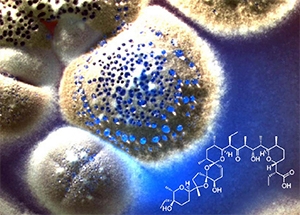Onderzoeksproject
Less is more: reduced mycelial heterogeneity for improved production of enzymes and antibiotics
Hoe kan de techniek van cell wall engineering worden ingezet zodat de industrie streptomyceten beter kunnen verwerken tot nieuwe antibiotica?
- Contact
- Dennis Claessen
- Financiering
-
 STW Vidi (2013)
STW Vidi (2013)
- Partners
- DuPont Industrial Biosciences (Leiden)
- Prof. dr. Han Wösten (Utrecht University, NL)
- Dr. Klas Flärdh (Lund University, SE)
- Prof. dr. Jeff Errington (Newcastle University, UK).
 The majority of clinically important antibiotics that are used to combat bacterial infections are derived from filamentous, multicellular bacteria, called streptomycetes. In addition to antimicrobials, and also other medically relevant natural products including anticancer agents, these organisms produce numerous enzymes for medical and technical applications. Many of these enzymes are most efficiently produced by streptomycetes themselves (
i.e. not by other cell factories), because they require host- specific machinery for their folding, modification and release into the medium.
The majority of clinically important antibiotics that are used to combat bacterial infections are derived from filamentous, multicellular bacteria, called streptomycetes. In addition to antimicrobials, and also other medically relevant natural products including anticancer agents, these organisms produce numerous enzymes for medical and technical applications. Many of these enzymes are most efficiently produced by streptomycetes themselves (
i.e. not by other cell factories), because they require host- specific machinery for their folding, modification and release into the medium.
Growth of streptomycetes in fermenters is characterized by the formation of so-called pellets of interconnected filaments known as hyphae. The typical size heterogeneity of these pellets strongly reduces the desired specific productivity, which is one of the main reasons for the sub-optimal performance of streptomycetes in bioreactors.
This project tackles the heterogeneity in productivity by applying innovative cell-wall engineering approaches. This knowledge will be used to develop uniform Streptomyces cell factories that are tailored for the production of (novel) enzymes and antimicrobials. This project strongly benefits from the expertise in Leiden and from collaborations with outstanding research groups, and is also supported by major biotech industry. Taken together, this work will contribute to the sustainable production of bulk enzymes and future generations of antimicrobials.
M.D. van Dissel, D. Claessen and G.P. van Wezel (2014). Morphology of streptomycetes in liquid-grown cultures. Advances in Applied Microbiology 89, 1-45.
D. Claessen, D.E. Rozen, O.P. Kuipers, L. Søgaard-Andersen and G.P. van Wezel (2014). Bacterial solutions to multicellularity: a tale of biofilms, filaments and fruiting bodies. Nature Reviews in Microbiology 12 (2), 115-124.
G.J. van Veluw, M.L.C. Petrus, J. Gubbens, R. de Graaf, I.P. de Jong, G.P. van Wezel, H.A.B. Wösten and D. Claessen (2012). Analysis of two distinct mycelial populations in liquid-grown Streptomyces cultures using a flow cytrometry-based proteomics approach. Applied Microbiology and Biotechnology 96 (5), 1301-1312.
W. de Jong, H.A.B. Wösten, L. Dijkhuizen and D. Claessen (2009). Attachment of Streptomyces coelicolor is mediated by amyloidal fimbriae that are anchored to the cell surface via cellulose. Molecular Microbiology 73 (6), 1128-1140.
D. Claessen, R. Rink, W. de Jong, J. Siebring, P. de Vreugd, F.G.H. Boersma, L. Dijkhuizen and H.A.B. Wösten (2003). A novel class of secreted hydrophobic proteins is involved in aerial hyphae formation in Streptomyces coelicolor by forming amyloid-like fibrils. Genes & Development 17 (14), 1714-1728.
